
France - electric and diesel multiple units of SNCF
For a full scale picture, please click on the picture shown !
Transilien - Local train traffic around Paris
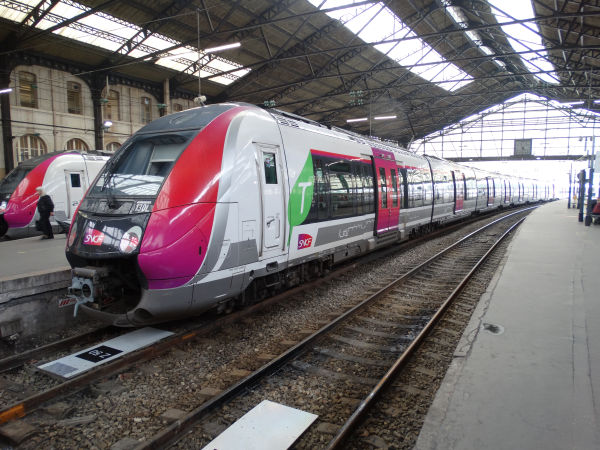
These are currently - in 2018 - the newest trains of the Transilien regional train service around Paris.
This train type is the SNCF's class Z50000 also known as "Francilien". They are in service since 2009. They were built by
Bombardier and Crespin and they come in two versions: 94,3 metres and 112,5 metres long. Their maximum speed is 140 km/h.
Picture from Paris Gare St. Lazaire station 5.6.2018 by Ilkka Siissalo.
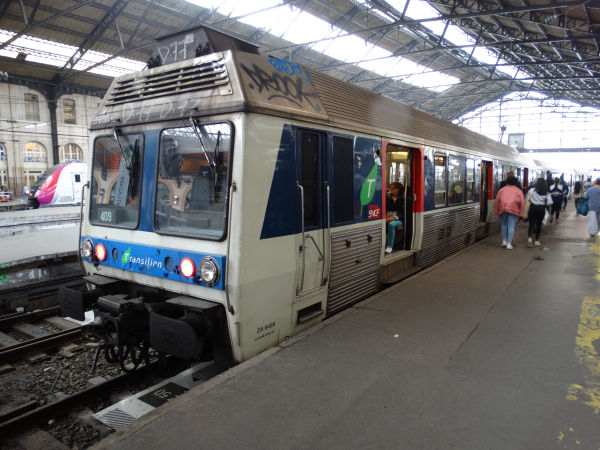
A very old Transilien electric multiple unit of the class ZA6400. These 25 kV AC old EMU trains were built 1976-79
by the companies Carel-Fouché-Languepin and Alsthom and modernised 1999-2005. In May 2018 there were still 53 trains out of an original
number of 75 trains left. They have only been in use with Transilien = the regional TER service of the Île-de-France area around Paris.
Picture from Paris Gare St. Lazaire station 5.6.2018 by Ilkka Siissalo.
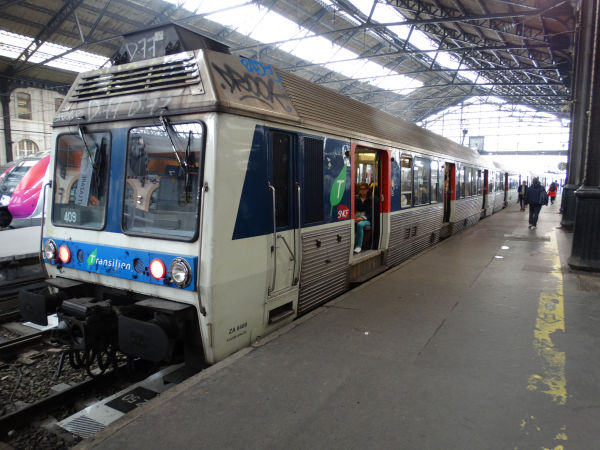
Another picture of the same old ZA6400 train.
Picture from Paris Gare St. Lazaire station 5.6.2018 by Ilkka Siissalo.
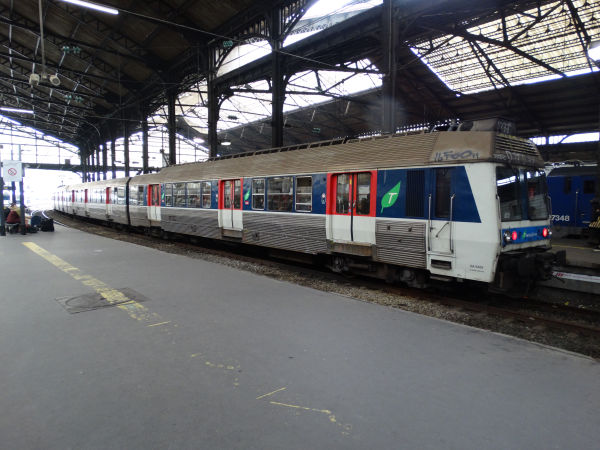
Side view of an old ZA6400 train.
Picture from Paris Gare St. Lazaire station 5.6.2018 by Ilkka Siissalo.
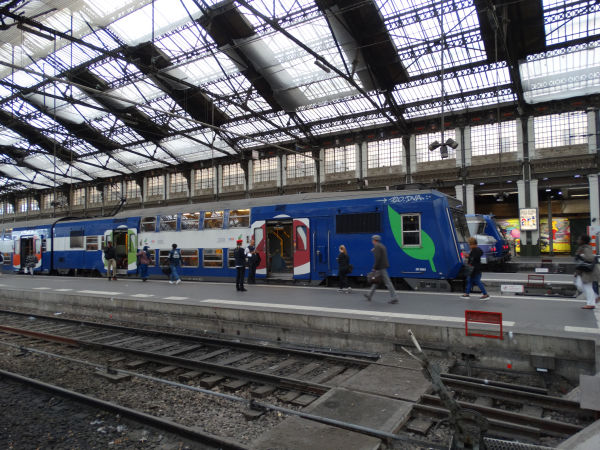
A very common train type in the Transilien service is the Z20500 double decker train. They were built by CIMT, ANF and
Alsthom in 200 copies since 1988. It is also known as the Z2N train.
Picture from Paris Gare de Lyon 19.10.2017 by Ilkka Siissalo.
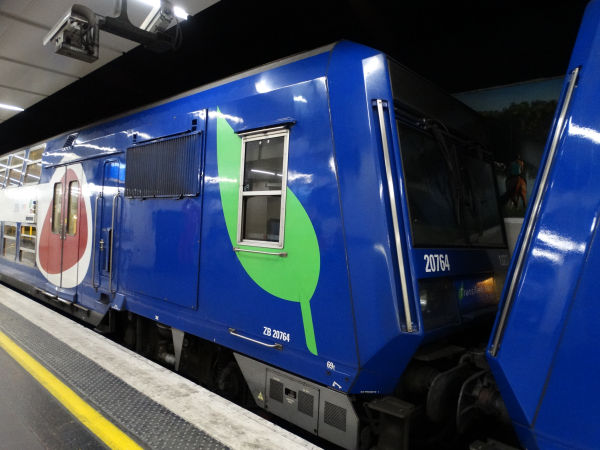
Closeup picture of the front of another Z20500 train of Transilien.
Picture from Paris Gare de Lyon 19.10.2017 by Ilkka Siissalo.
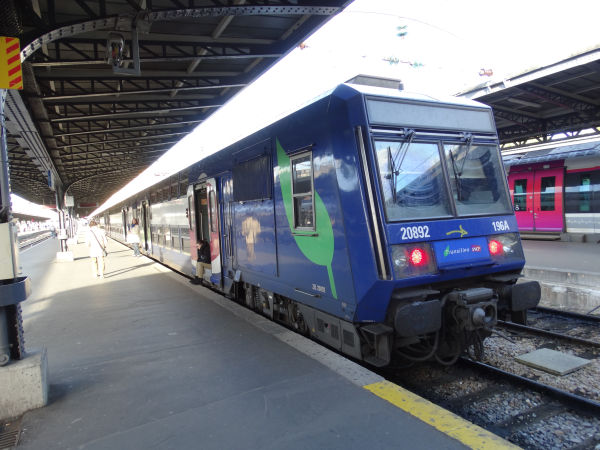
Another Z20500 train of Transilien.
Picture from Paris Gare de l´Est 20.10.2017 by Ilkka Siissalo.
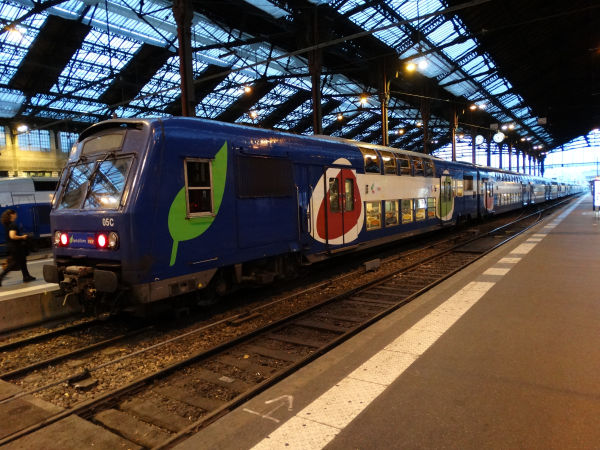
This is actually not an electric motor unit train, so it should not be presented in this category, but
since the other Transilien trains are here, we will make an exception to our own rules. So this is not an EMU, it is just a set of
coaches, normally pulled or pushed by one of the Alstom Prima locomotives. These coach rakes are called VB2N. It stands for
Voiture de banlieue à 2 niveaux, meaning just a rake of double decker coaches. They were built by CIMT and ANF 1974-84. Total
number of coaches built was 589. They are used especially for the very long rush hour trains, just like here.
Picture from Paris Gare de Lyon 19.10.2017 by Ilkka Siissalo.
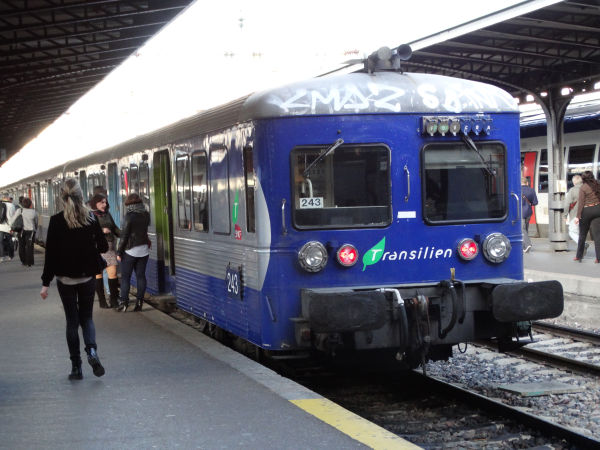
Just like in the picture above, this is also not a full EMU, but just a rake of coaches. These coaches are known
as inox coaches, because originally they were not painted at all but just showed the grey colour of inox steel. They came in several
varieties since 1963. This set in the picture is from the newest batch RIB76 (Rame Inox de Banlieue 1976). They were modernised and
partly painted 2002-07 and Transilien stated they wanted to use still some of them until there are enough of the new Francilien trains
(see above) available.
Picture from Paris Gare de l´Est 20.10.2017 by Ilkka Siissalo.
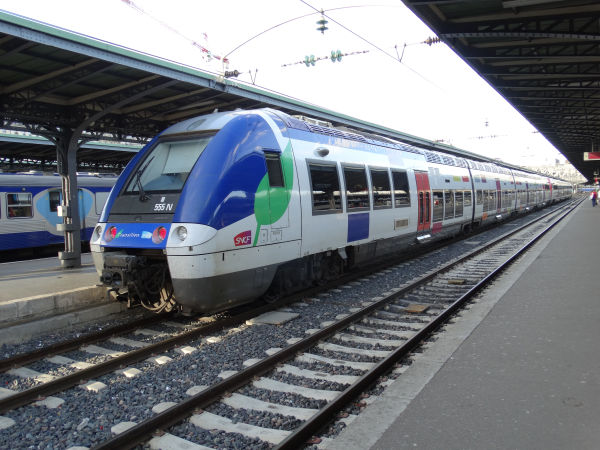
This train is of the class Z27500, better known as the AGC train. AGC stands for Autorail grande capacité,
or a multiple unit of large capacity. These were built 2005-2010 by Bombardier. It is a very common regional train in all parts of
France in the local TER train services, but there are not very many of them in Paris area Transilien service. They are available
as three or four coach versions. Transilien only has the longer ones.
Picture from Paris Gare de l´Est 20.10.2017 by Ilkka Siissalo.
RER trains (Réseau Express Régional)
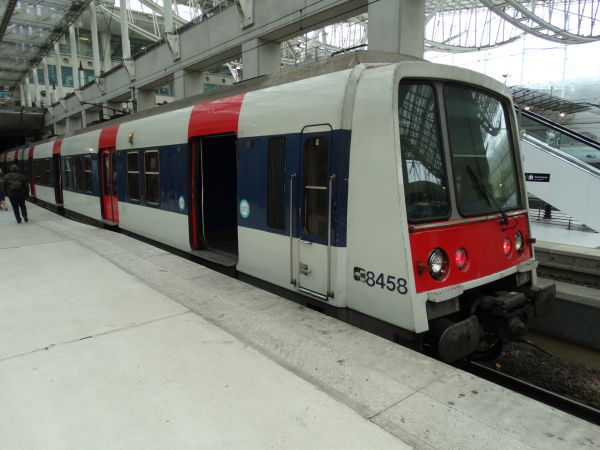
The RER trains are a strange mixture of "real" trains and metro trains. In and around Paris there are five RER train
lines marked with letters A to E. There are two operators, SNCF Transilien and RATP and two electric systems, RATP's 1,5 kV DC and Transilien's
25 kV 50 Hz. RATP operates the RER lines A and B and Transilien the lines C, D and E. Electricity is always taken from an overhead catenary
and some of the train models used can operate under both currency systems.
This train is RATP's class MI 84, also known as Z8400. It can operate with both 1,5 kV and 25 kV. 73 trains of this type were built 1989 to 1998.
Picture from the Paris Charles de Gaulle airport's RER station 21.10.2017 by Ilkka Siissalo.
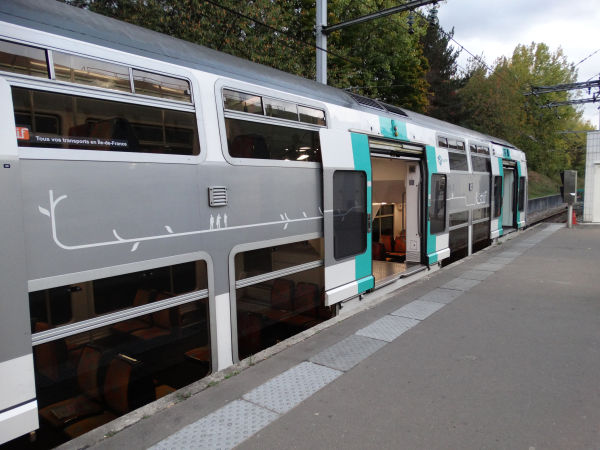
RATP's class MI 09 double decker RER train seen from its side. These are really high capacity trains offering a very similar
service than the Transilien trains do. This train model was built by Alstom since 2011 and it is only used on RER line A. Its maximum speed is
120 km/h.
Picture from Marne la Vallée station 19.10.2017 by Ilkka Siissalo.
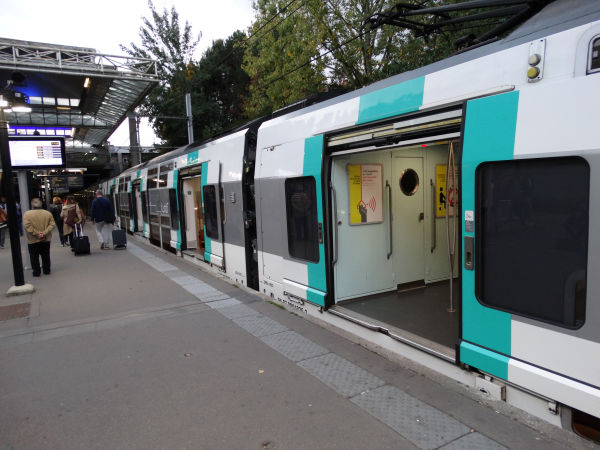
Another view of the same MI 09 train.
Picture from Marne la Vallée station 19.10.2017 by Ilkka Siissalo.
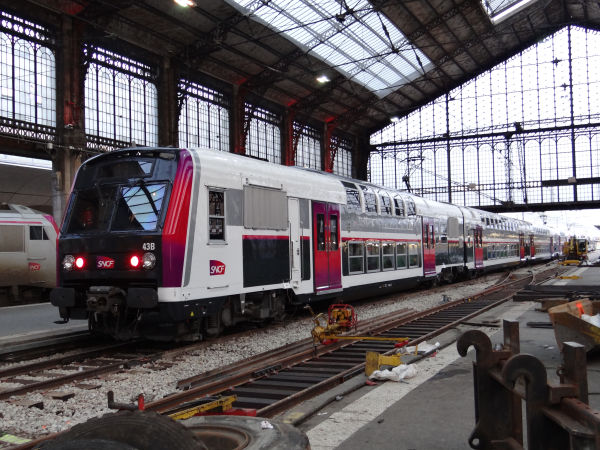
A class Z5600 train of SNCF Transilien, but serving in RER traffic and now with a totally new livery of SNCF. It is a derivative of the VB2N
coaches (See above how very similar they look!). They were built 1982 to 1985 and modernised 2009-2017. They are used not only in the RER traffic
of Paris but also at Transilien and several other TER services such as the TER Bourgogne-Franche-Comté.
Picture from Gare d´Austerlitz 4.3.2014 by Ilkka Siissalo.
Regional TER trains and Intercité trains
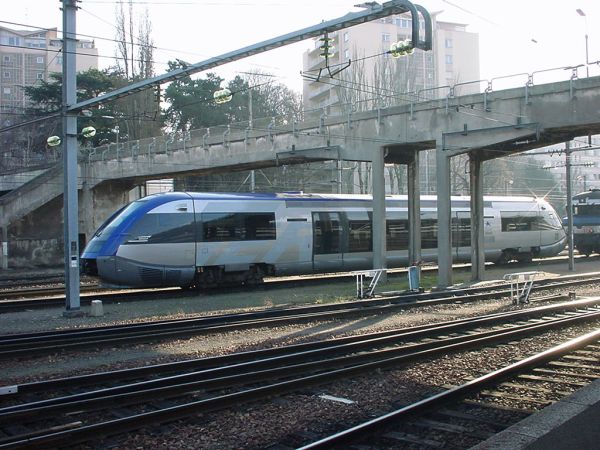
This is a modern diesel railbus known as the Alstom Coradia TER or SNCF's class X73500. In Germany the same trains are called Br 641
and they used to be used in Luxemburg as well. Anyway, in France they are best known with their common nickname "Baleine" or blue whale
mainly because of the ventilation openings under the front of the train which remind people of a baleen whale's head and mouth structure.
Picture from Mulhouse 3.2.2002 by Ilkka Siissalo.
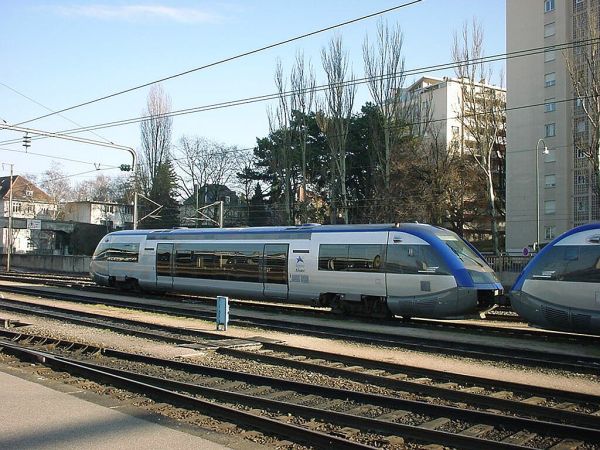
Another X73500 "Baleine". These new railbuses are now common on the many small sidetracks of the Vosges mountains' sidelines.
Picture from Mulhouse 3.2.2002 by Ilkka Siissalo.
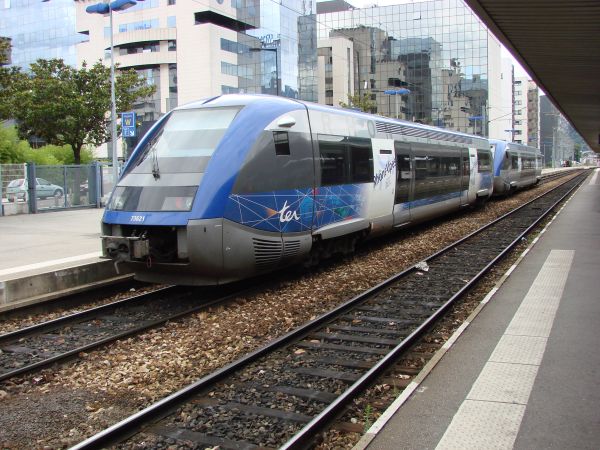
Still another X73500 "Baleine" but now in the colours of SNCF Rhône-Alpes.
Picture from Grenoble 26.6.2007 by Ilkka Siissalo.
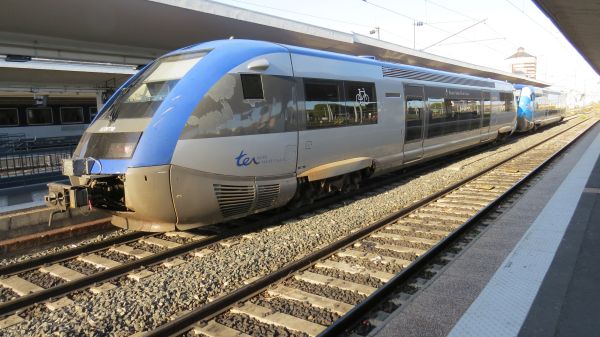
This one is also one of the X73500 "Baleine" railbuses. But this picture caused a lot of wondering. For one thing this individual has been
marked as belonging to the TER Nord Pas de Calais in the very north of France and this picture was taken in Clermont Ferrand, so it was really far away
from "home". And secondly: Look closely at its front. There's some mysterious grey box right on top of the Scharfenberg coupler mounted as if
it would be looking at or measuring the tracks in front. And there was a similar box also at the other end of this unit. This has led to
speculation that maybe this unit was performing some kind of measurements in Clermont Ferrand. That might also explain why it was so far from its normal
area of operation. But so far we haven't been able to find a published explanation as to what these boxes are.
Picture from the station Clermont Ferrand 21.10.2024 by Ilkka Siissalo.
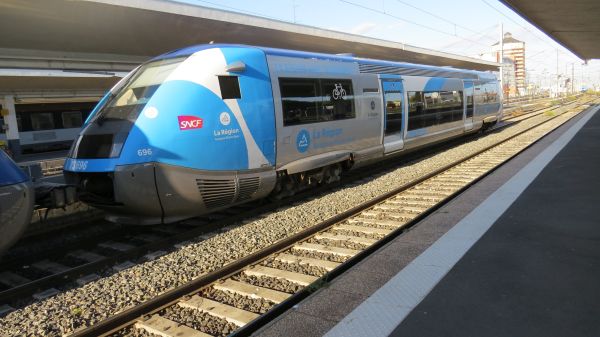
This is the other Baleine unit that could be seen on the right in the picture above. You can also see the mysterious grey box of the Baleine
in front of it just at the left rim of the photo. But neither this unit nor any one of the five or so other Baleine units which were at that
time present at the Clermont Ferrand station exhibited such grey boxes. This one has the typical light blue and white tapings of
"La Région Auvergne-Rhône-Alpes".
Picture from the station Clermont Ferrand 21.10.2024 by Ilkka Siissalo.
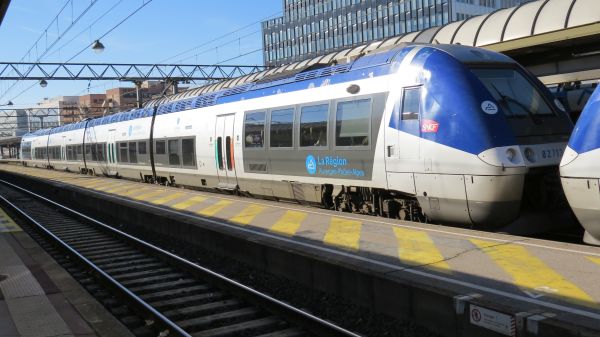
AGC trains (Autorail à Grande Capacité) were already presented above. But there are several varieties of these AGC trains. Some are three
coaches long, some four, most are pure diesels but then there are also these "polyvalent AGC" trains that can run as diesels in places
with no overhead electric lines, but can also use either 25kV AC as well as 1,5 kV DC whenever that is available. This one is a polyvalent
AGC of the class B82500 with four coaches, here being used as a TER train for the region "La Région Auvergne-Rhône-Alpes". These trains
were first taken in use in 2007 and they were made by Bombardier's plant in Crespin.
Picture from Lyon 21.10.2024 by Ilkka Siissalo.

This is another AGC train of the same "La Région Auvergne-Rhône-Alpes" like the one shown above, but this one is a three coaches long pure
diesel train. And it has been totally covered now by the local Région Auvergne-Rhône-Alpes sticker tapes.
Picture from the station of Clermont-Ferrand 21.10.2024 by Ilkka Siissalo.
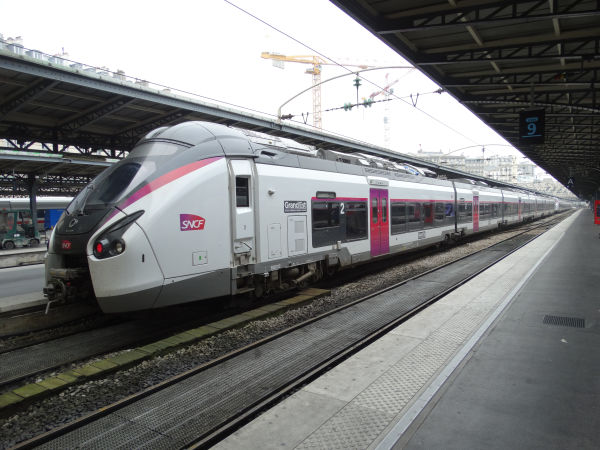
In 2018 locomotive pulled trains with coaches are getting more and more rare both in the regional train traffic (TER trains) as well
as Intercité trains (InterCity).In many cases the old locomotives and coaches have been replaced by these new trains. This is an Alstom
Coradia Polyvalent. It has both a diesel engine and the machinery of an electric multiple unit. This Coradia Polyvalent is working for
GrandEst, that is, in the Intercity and TER traffic of eastern parts of France, including Alsace, Lorraine and so on. The Coradia
Polyvalent trains can work under 1500V DC, 25 kV AC, with diesel fuel and versions for border crossing traffic also with 15 kV AC.
Three, four or six coach versions are available. Train length is 56, 72 or 110 m and up to three trains can be connected together.
Picture from Paris Gare de l´Est station 5.6.2018 by Ilkka Siissalo.
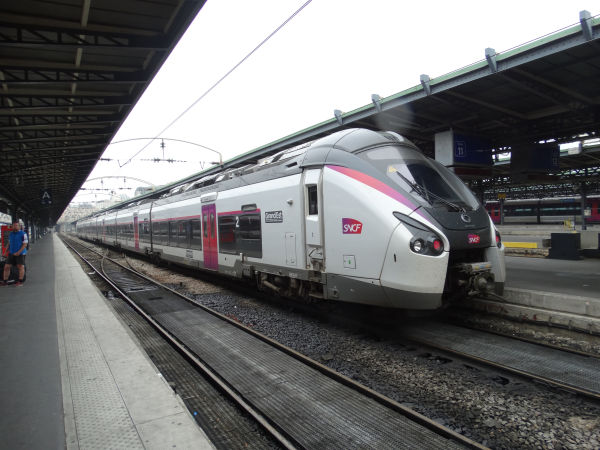
Another Alstom Coradia Polyvalent.
Picture from Paris Gare de l´Est station 5.6.2018 by Ilkka Siissalo.
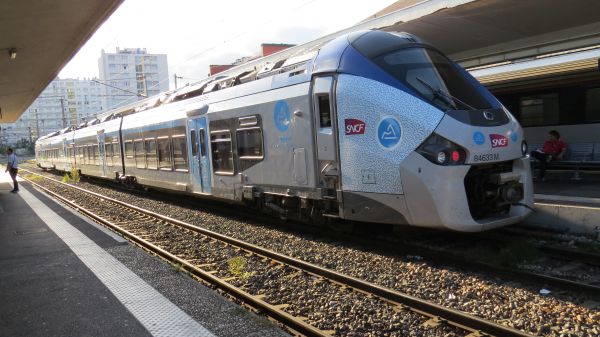
A four coaches long Alstom Régiolis EMU now in the local colours of the Région Auvergne-Rhône-Alpes. It very much resembles the Coradia
Polyvalent trains shown above. No wonder - they come from the same factory.
Picture from Clermont-Ferrand 21.10.2024 by Ilkka Siissalo.
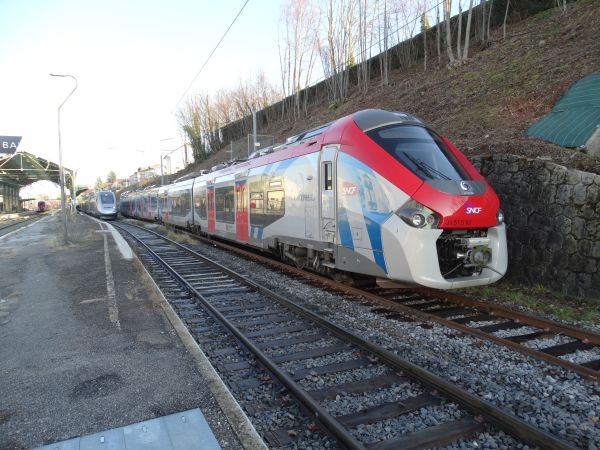
The Léman Express service is Europe's largest cross-border network of local trains running in the vicinity of Geneve. The Swiss SBB runs these
services with multiple current systems capable Stadler FLIRT trains whereas SNCF uses these Alstom Régiolis trains. It's a complex system: several
electric systems (1,5 kV DC, 15 kV AC and 25 kV AC) and several different train security systems.
Picture of a Léman Express Régiolis train is from Evian 8.2.2020 by Ilkka Siissalo.
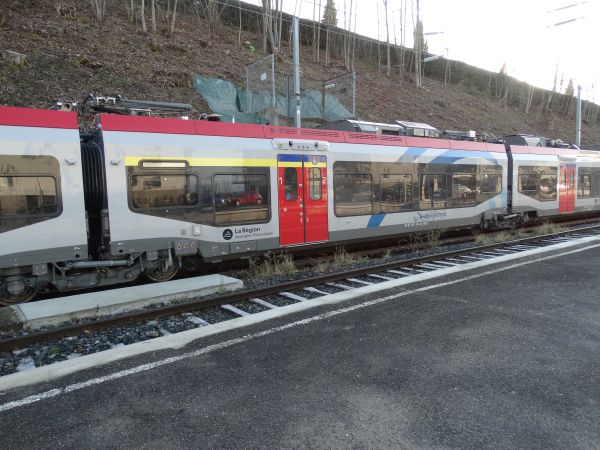
A closer look at one of the middle coaches of the Léman Express Alstom Régiolis train. Almost completely low-floor, with Jacobs bogies.
Picture of a Léman Express Régiolis train is from Evian 8.2.2020 by Ilkka Siissalo.

These totally new Bombardier Regio 2N double decker trains are intended for regional traffic with very frequents stops and lots of passengers.
The model has been built by Bombardier since 2014. They come in 6,7,8 or 10 coach train variants which have a top speed of 200 km/h and are
very fast in their acceleration capabilities. They are used by the different regional TER train services, such as here. This train belongs
to the TER services of Hauts-de-France.
Picture from Paris St Lazaire station 5.6.2018 by Ilkka Siissalo.
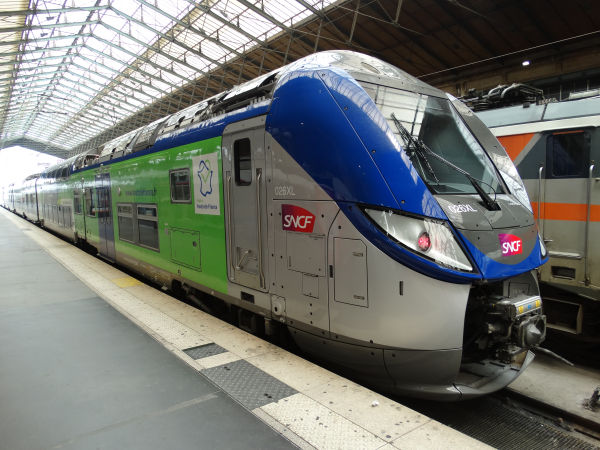
Another Bombardier Regio 2N of Hauts-de-France TER services.
Picture from Paris St Lazaire station 5.6.2018 by Ilkka Siissalo.
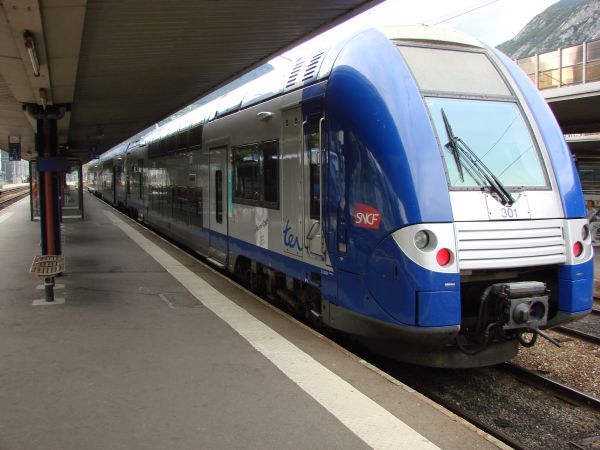
This train is the SNCF Z24500 also known as TER 2N NG (TER regional trains with two levels, new generation). These have been the precursors of the
Regio 2N trains shown above. These were built 2004-2010 in 211 copies. The short ones, just two or three coaches long, are called Z 24500 and the
longer ones, four to five coaches long, are called Z 26500. They were built by Alstom as a part of their Coradia Duplex train family. Also the
Luxemburg railways CFL bought similar trains, but painted them red and grey.
Picture from Grenoble 26.6.2007 by Ilkka Siissalo.
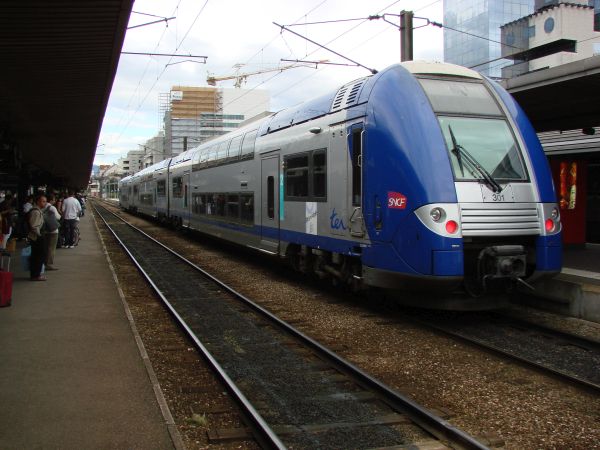
The same SNCF Z24500 seen now more from its side.
Picture from Grenoble 26.6.2007 by Ilkka Siissalo.
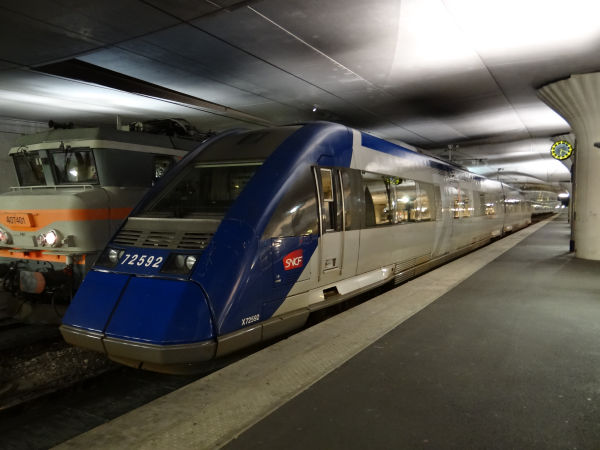
The SNCF class X72500 railbus is a diesel multiple unit, which is intended for fairly long distances but for non-electrified lines with fairly
few passengers. They operate longer distance TER and Intercites services, particularly in the areas south and west of Paris, the Paris to Laon line,
around Tours, Nantes, Toulouse, Lyon, Dijon, Nevers, Grenoble, Bordeaux and the South Coast of France, but not in the north of the country.
The model is a two coach railbus built by Alstom 1997-2002 in 117 copies. They have German MAN engines. Top speed is 160 km/h. Three two coach
sets can be coupled to one train when needed.
Picture from Paris Gare d´Austerlitz 4.3.2014 by Ilkka Siissalo.
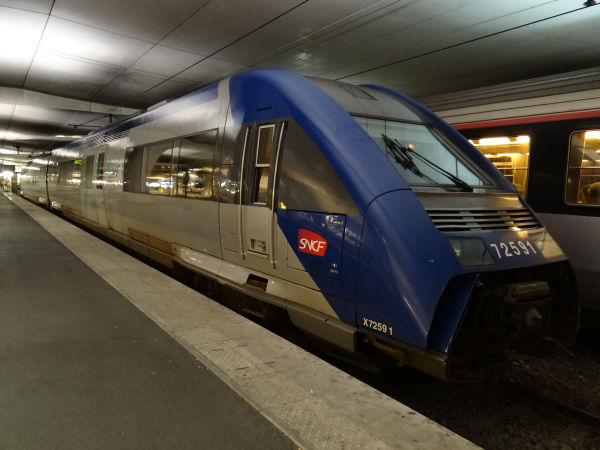
Another picture of the same X72500 railbus with its "mouth" open. This train belongs to the TER service of Region Centre.
Picture from Paris Gare d´Austerlitz 4.3.2014 by Ilkka Siissalo.
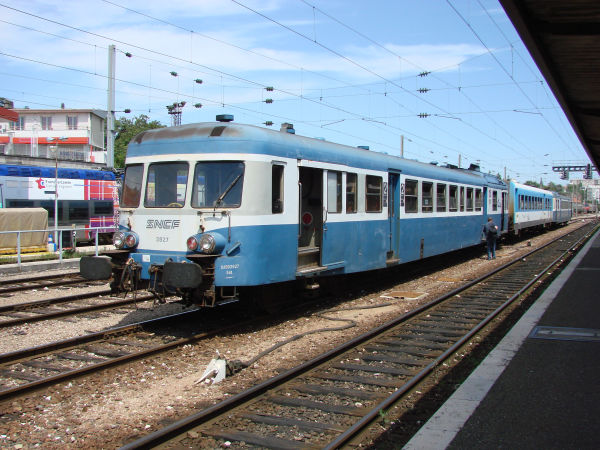
Two old SNCF railbuses of the class X2800 and one old express train coach in the middle, this train used to run the regional cross-border TER
service from Besançon in France to La Chaux-de-Fonds in Switzerland. These X2800 series railbuses were built by two companies, Decauville and
Renault between 1957 and 1962. They had one large MGO V 12 engine producing a modest power rating of 607 kW. Top speed was 120 km/h, for some units 140 km/h.
This unit no X2827 had been built by Renault. All these trains were taken out of commercial use in 2009 and only a few museum units have survived.
Picture from Besançon 16.7.2007 by Ilkka Siissalo.
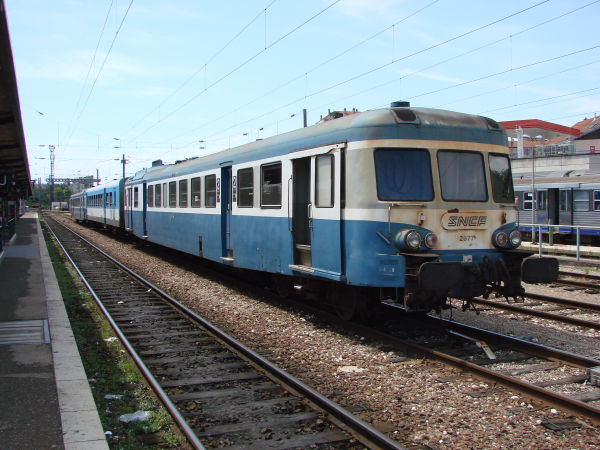
At the other end of the same TER train as shown above was this one, X2877. Also this individual had been built by Renault. During a hot summer day the personnel
had to keep the engine roon doors open at all times. The huge MGO diesels created a hell of a noise and also tremendously heat inside.
Picture from Besançon 16.7.2007 by Ilkka Siissalo.
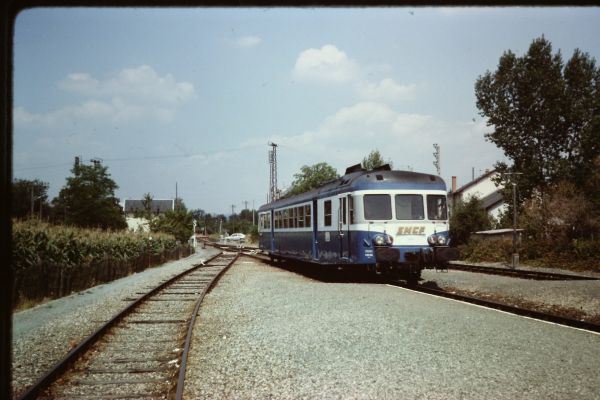
A similar X2800 railbus in the 1980s.
Picture from Neucelles near Albi 1981 by Adrian Gray.
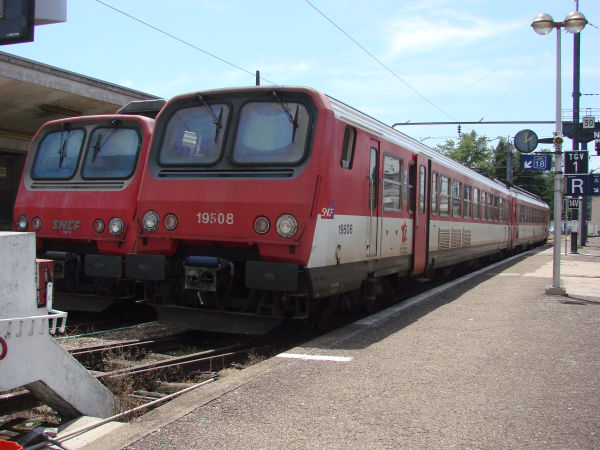
Two class Z9500 electric multiple units still in their original red and white TER livery. Later these same trains were repainted blue and grey. These class Z9500 trains were
built 1982-83 for SNCF's TER services in Bourgogne, Franche-Comté and TER Rhône-Alpes. There were 20 of these trainsets alltogether. The train was designed to run both on
1,5 kV DC as well as 25 kV AC. Top speed was 160 km/h.
Picture from Besançon 16.7.2007 by Ilkka Siissalo.
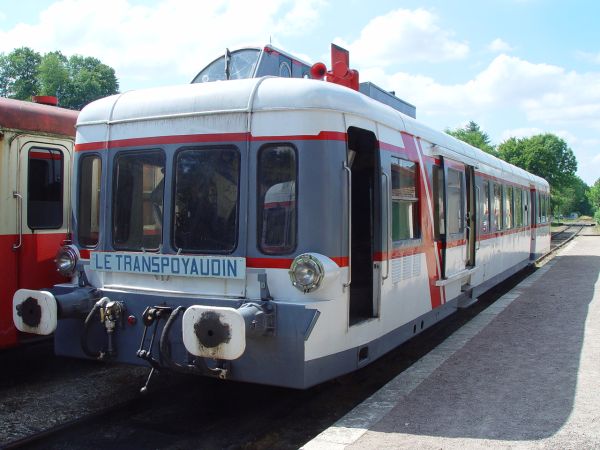
This old formerly SNCF's railbus of the class X3800 is here seen as a touristic train "Le Transpoyaudin" based in the Yonne area in Bourgogne. These odd
looking railbuses with elevated driver's cabs used to be common throughout France. The train was called Picasso because Pablo Picasso often portrayed
people for example so that the person's nose was totally misplaced on his/her face. These Picasso trains were built 1950 to 1961 by Renault, ANF, De Dietrich
and SACM. They were numbered from X3801 to X4051. They had either Saurer or Renault diesel engines with a modest power output of only 250 kW. They were used
on small sidelines in all parts of France. This one was serving on a touristic train called Le Transpoyaudin.
Picture from the station of Toucy-Ville 16.7.2004 by Ilkka Siissalo.

Another similar X3800 "Picasso" railbus. This one also belongs to the "Le Transpoyaudin" or Autorails Touristiques de l'Yonne. But this one still needs a
lot of work to be done before it's ready to haul tourists. However, it shows clearly the unconventional driver's cab of this train type.
Picture from the station of Toucy-Ville 16.7.2004 by Ilkka Siissalo.
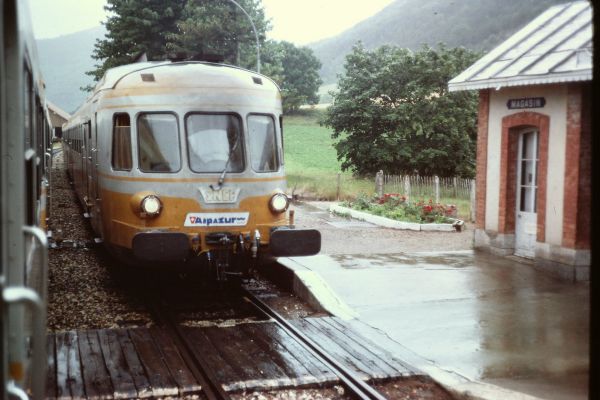
L'Alpazur was a train service linking Geneve with Nizza (Nice) 1959 to 1989. The original Alpazur service required passengers to twice change trains
because a section of the route was operated on metric narrow gauge lines. Various types of diesel multiple units were used at different times, but
this one was the X2720, an "autorail" or railbus which was built by De Dietrich 1955 to 1956. There were 18 of these trains in these colours plus a
further 10 in the famous Trans-Europ-Express colours. These had a power rating of 605 kW and a maximum speed of 140 km/h. All were taken out of use
between 1999 and 2006. Here we see one of these railbuses in Alpazur colours as it has gone to a siding to let an express train pass.
Picture from La Croix Haute in 1982 by Adrian Gray.

